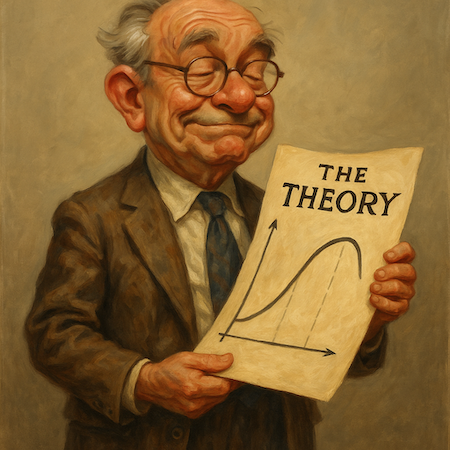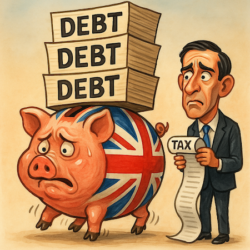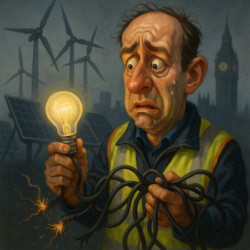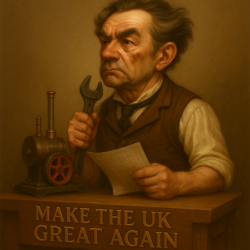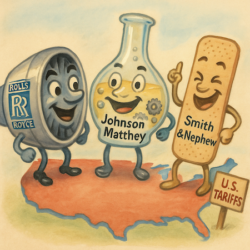- How the Phillips Curve gave us inflation and immigration
- Count yourself lucky, it usually causes worse
- Gold is telling us what happens next
Bad ideas cost money…at best. Sometimes they kill millions of people. And not always deliberately.
What’s astonishing is that such ideas don’t go away when they fail. We seem to be stuck with them.
This creates a whopping great opportunity for investors. They can spot the rhythms of history. And profit from them.
Today, I want to show you how one such episode led to the UK’s economic and political instability we’re stuck in today.
One bad idea gave us both the inflationary spike and the immigration surge now known as the Boriswave. That idea is called the Phillips Curve, named after the economist who came up with it in 1958.
It’s all his fault…
What is the Phillips Curve?
It’s surprisingly simple. The Phillips Curve claims there’s a relationship between unemployment rates and inflation.
Low unemployment rates cause employers to raise wages to attract staff. Those higher wages earned by more workers bid up the price of consumer goods.
High unemployment means less workers and lower wages, so inflation goes down.
A derivative of this idea is called the NAIRU. It helps make the Phillips Curve concept a little clearer.
The Non-Accelerating Inflation Rate of Unemployment is the unemployment rate at which inflation isn’t pushed up or down.
Say the NAIRU is 5%. If unemployment falls below this level, the number of workers and their higher wages cause inflation to go up. If unemployment is higher than 5%, lower wages and less workers cause inflation to stop.
The Phillips Curve and NAIRU are why central bankers watch employment rates carefully to determine what inflation might do next. Except for German central bankers, that is.
The Bundesbank is famous for not giving two hoots about unemployment rates. Because they know the Phillips Curve is complete rubbish.
The relationship between employment and inflation might sound good in theory. But Germany’s rather harsh experience with both 100 years ago proves it is wrong.
What’s wrong with the Phillips Curve?
There are many flaws. First of all, rising consumer prices can be caused by many different things. If you misdiagnose the cause by presuming it’s linked to employment, your cure can be worse than the disease. That’s what happened in the UK, leading to the Boriswave.
But let’s tackle the Phillips Curve on its own ground first…
Workers don’t just consume. They also produce. And so, employment increases the amount of stuff we can buy, not just the amount of money chasing those goods. As a result, there needn’t be a link between employment and inflation.
Not only this, but employment booms tend to result from higher productivity, which is deflationary. The Industrial Revolution caused deflation despite employing vast amounts of people because we made more stuff.
The Phillips Curve has been disproven countless times throughout history. Its obituaries are practically a periodical. And yet, it keeps coming back to haunt us.
Most recently, this idea infected the minds of our central bankers back in 2021. Causing the disastrous waves of inflation and politically dangerous waves of immigration we’ve seen in much of the English-speaking world.
Before we get to the UK, a clear-cut example that’s very revealing comes from Australia…
Believing the wrong theory caused our inflation
In 2021, the Reserve Bank of Australia (RBA) promised not to raise interest rates until wage growth took off. They also predicted that wages wouldn’t rise until sometime in 2024. Which, when you put the pieces together, amounted to a promise not to raise interest rates until 2024.
Waves of borrowers flooded the housing market, encouraged by absurdly cheap mortgages for years to come.
Within the year, the RBA was imposing panicked interest rate hikes without wage growth. Mortgage rates doubled, but people weren’t earning more, and their cost of living was spiking at the same time – a triple whammy.
The RBA Governor later apologised. But this was cold comfort for the borrowers who had mortgaged up based on the RBA’s promise not to raise rates.
What went wrong?
The RBA presumed that inflation could only emerge from wage growth. It presumed the Phillips Curve was true and the sole source of truth at that.
But we all know inflation is caused by the money supply. Which the RBA had flooded the economy within response to COVID…
So, not only was the RBA the cause of the inflation, it also failed to respond to it and then broke its promise to keep rates low. The central bank could not have failed more comprehensively.
Worst of all, interest rate hikes don’t do much to slow inflation caused by money supply spikes. They just make the cost-of-living crisis even worse.
You can imagine the anger in Australia. Not that there were consequences, of course…
The only thing making voters more angry is the immigration wave. But, according to our former Prime Minister back home, that was caused by the Phillips Curve too…
The source of the Boris Wave
In an interview with the Telegraph, Boris Johnson recently explained what led to the spike in immigration under his and the subsequent government.
His first point was that the UK does not have timely immigration statistics. Which is extraordinary. All those hours queuing at airports, renewing passports, and answering stupid questions, and the civil servants don’t even count us!
So, the government was unaware that the Boriswave was happening…
More interesting was why it happened. Boris’s suspicion is that the Treasury presumed the inflation spike of 2021 was caused by a labour shortage. You can watch the relevant excerpt of the interview here.
How do you solve inflation caused by a labour shortage? By flooding the economy with immigrants!
Again, this presumes that the Phillips Curve is correct. It links inflation with the number of workers and their wages.
But if worker shortages caused inflation, then Japanese and Korean workers would be the richest in the world. And their consumer prices would’ve been surging for years.
The opposite has happened.
Applying the Phillips Curve to the post-pandemic inflation was a stupid idea at the time. The Bank of England had just printed money hand-over-fist – a real gorilla in the inflation statistics nobody should’ve ignored.
But belief in the Phillips Curve caused the immigration wave that is so unsettling UK politics today. Not to mention the inflation persisting longer than expected thanks to the misdiagnosis.
It’s worth mentioning that all through this period, Nigel Farage kept telling me that “inflation is a disease of money” in our weekly YouTube videos. His point was that the money supply, not the Phillips Curve, was behind inflation.
Together, we published a prediction in April 2021 that inflation was about to surge. The surge began that very month.
Count yourself lucky
This isn’t the first time a Phillips Curve Cult took over our government. Past episodes caused far more damage and lasted far longer. A.W. Phillips can be blamed for all sorts of disastrous episodes.
In 2022, governments and central bankers quickly moved on from the Phillips Curve to other defunct delusions about inflation. They began to blame foreigners mucking up supply chains. And then expensive fossil fuels. Anything but the money supply they had spiked…
Historians will laugh at us just as we laugh at those who made this mistake in the past. And, let me tell you, we have plenty of company.
The big question now is whether our political elites have learned their lesson. Except, of course, Nigel Farage, who failed to forget it in the first place…
The soaring gold price is telling us that, as Milton Friedman said, “governments never learn.”
Until next time,

Nick Hubble
Editor at Large
P.S. As this story shows, bad ideas have consequences — and governments never seem to learn. The same policies that caused past crises are being recycled again today. But that also means the next great shift in markets is predictable. James Altucher calls this kind of moment a “Wealth Window” — a brief period when the mistakes of policymakers create once-in-a-decade opportunities for investors who know where to look. He’s just revealed one that could open right here in the UK. You can see the full details right here.
